Stud and track making machines are used to manufacture metal studs and tracks for building construction projects. This equipment forms C-shaped studs and U-shaped tracks from coiled sheet metal in a continuous process.
Overview of Stud And Track Making Machines
Stud and track making machines, also known as roll forming machines, transform flat strips of sheet metal into studs and tracks through a series of bending and shaping processes using roller dies.
Key features:
- Produce studs and tracks for wall framing and light-gauge steel construction
- Form complex cold-rolled sections out of metal coils
- Adjustable for different metal thickness and stud specifications
- High production capacity up to 80 feet per minute
- Automated with PLC-based controls
Applications:
- Manufacturing metal studs and tracks for drywall framing
- Walls, partitions, shaft walls, exterior curtain walls
- Infill wall panels, façade cladding, roof trusses
Industry sectors:
- Building and infrastructure
- Residential and commercial construction

Working Principle of Stud and Track Making Machines
Stud and track makers utilize a रोल बनाना technique to shape sheet metal. This involves feeding a metal strip through a series of roller dies that bend the strip incrementally to the desired profile.
The process starts by feeding a coil of galvanized sheet steel into a de-coiling machine. The sheet then passes through a straightening mechanism to remove coil curvature.
Next, the flattened strip enters the forming section consisting of roller dies arranged in a sequential order. As the sheet passes over the rolls, it gets bent gradually into the final C or U shape.
After forming, the studs and tracks may undergo piercing, notching, cutting as per requirement using automated punch and shear tools. Finally, a cooling system may be present to temper the sections before exiting the machine.
Advanced stud and track makers provide programmable controls to set diameters, hole patterns as per custom stud designs.
Types of Stud And Track Making Machines
There are two main types of metal stud and track forming equipment:
1. C-Shape Stud and Track Roll Forming Machine
- Roller dies form C-shaped studs and U-shaped tracks
- Outputs common industry standard profiles
- Lower cost, high production efficiency
- Limited to standard shapes, less flexibility
2. Customized Stud and Track Roll Former
- Forms special profiles other than standard C and U sections
- Advanced roller sets can make complex bends and curves
- PLC programming allows custom profile creation
- Punching units provide hole patterns as required
- Higher initial cost but wider range of profiles
Main Components of a Stud and Track Machine
A stud and track roll former consists of several modular components:
Feeding Unit
- De-coils and straightens sheet metal coil inputs
- Feed rollers engage and transmit sheets into system
Forming Section
- Sequential roller dies make incremental bends
- Forms metal coil into C/U channel over length
**Punching Unit **
- Automated punch tools cut holes as needed
- For electrical outlets, ventilation, ducts etc.
Shearing Unit
- Shears formed studs and tracks to length
- May have rotating shear for angled cutting
Controller
- PLC automates production via HMI touchscreen
- Stores forming profiles, I/O control
-
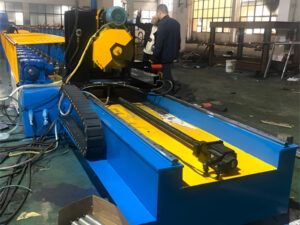 संयुक्त रैक स्टील बीम रोल बनाने की मशीन
संयुक्त रैक स्टील बीम रोल बनाने की मशीन -
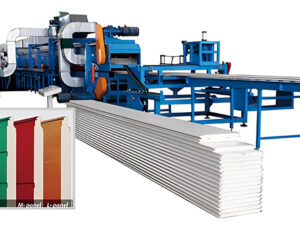 गेराज दरवाजा पैनल रोल बनाने की मशीन
गेराज दरवाजा पैनल रोल बनाने की मशीन -
 चैनल प्रकार ट्रंकिंग केबल ट्रे मशीन
चैनल प्रकार ट्रंकिंग केबल ट्रे मशीन -
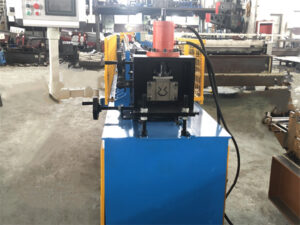 वी स्ट्रट रोल बनाने की मशीन
वी स्ट्रट रोल बनाने की मशीन -
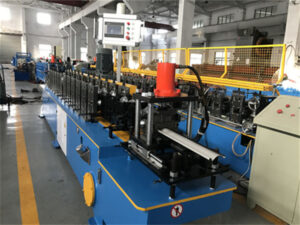 फायर डम्पर ब्लेड रोल बनाने की मशीन
फायर डम्पर ब्लेड रोल बनाने की मशीन -
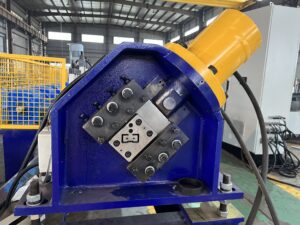 उपकरण ब्रैकेट सी स्ट्रट रोल बनाने की मशीन
उपकरण ब्रैकेट सी स्ट्रट रोल बनाने की मशीन -
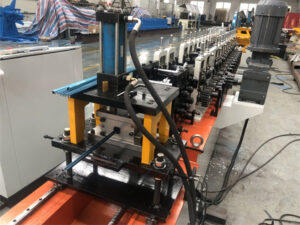 ग्लास विंडो सपोर्टर मशीन के लिए स्टेनलेस यू चैनल
ग्लास विंडो सपोर्टर मशीन के लिए स्टेनलेस यू चैनल -
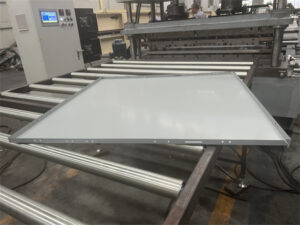 रॉकवूल सैंडविच पैनल लाइन
रॉकवूल सैंडविच पैनल लाइन -
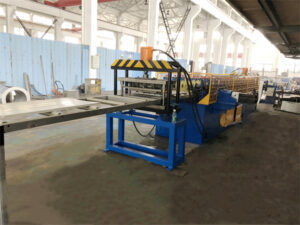 धातु स्टील रैकिंग बैक के लिए शेल्फ पैनल रोल बनाने की मशीन
धातु स्टील रैकिंग बैक के लिए शेल्फ पैनल रोल बनाने की मशीन
Stud and Track Specifications
Standard product dimensions that can be formed by these machines:
| पैरामीटर | Stud Spec Range | Track Spec Range |
|---|---|---|
| Metal Thickness | 0.3 – 1 mm | 0.3 – 1.2 mm |
| Finished Width | 35 – 300 mm | 40 – 350 mm |
| Web Depth | 50 – 220 mm | 50 – 250 mm |
| Length | 300 – 6000 mm | 300 – 6000mm |
- Custom profiles possible via tooling changes
- Hole patterns can be introduced as per requirements
Industrial Applications of Stud And Track Machines
- Drywall Framing – Manufacture C studs and U tracks for interior walls and partitions using plasterboards and insulation sheets fixed on frames
- Wall Panels – Produce straight panels, curved panels using custom stud profiles
- Framing in Steel Structures – Light gauge load bearing studs as alternative to wood frames for floors and roofs
- मॉड्यूलर निर्माण – Prefabricated wall, floor and roofing sections made of metal stud framing
- Cold Storage Buildings – Metal stud walls assembled with specialized insulated panels for chilled warehouses and frozen rooms
How To Choose A Reliable Stud And Track Making Machine Supplier
Choosing the right stud and track roll forming machine manufacturer is crucial for production efficiency, quality, and cost-effectiveness. Here are important factors to consider:
Technical Expertise
- Advanced roller die design, high precision parts
- Latest automation features for optimum productivity
- Rigorous machine testing prior to dispatch
Customization Capabilities
- Flexibility to develop tools for new profiles
- Programming skills for custom control parameters
Quality Focus
- Stringent incoming material inspection
- Process control and quality checks
- International quality certification
Services
- Guidance on appropriate machine selection
- Efficient installation, operator training
- Post-sales support, maintenance contracts
Cost
- Competitive pricing considering functionality
- Total cost including auxiliary equipment
- Consider TCO over lifetime instead of just initial price
Reliability
- Proven track record, years in business
- Case studies of similar roll formers supplied successfully
- Quick turnaround of spares, responsive aftersales service
Leading manufacturers like UNICOIL, SuperRoll, Formtek, Epicenter Equipment also focus extensively on these aspects while providing stud and track roll forming lines customized to application requirements.
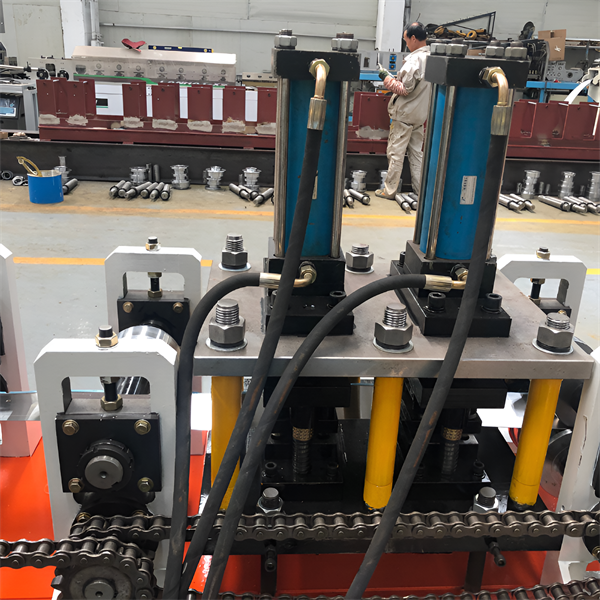
Installation and Operation
Installation
Proper machine installation is vital for smooth functioning. This includes:
- Securing the equipment bases firmly to the floor
- Leveling and alignment using shims
- Electrial connections to control panels
- Trial runs to confirm correct working
Operation
Despite automation, trained operators are required for:
- Proper feeding of raw coil to prevent jams
- Monitoring formed components for defects
- Tool setup changes for different profiles
- Routine maintenance and lubrication
Safety
Personnel safety mechanisms crucial due to moving parts:
- Guards around rotating shafts and gears
- Markers indicating pinch points
- Emergency stop buttons in right positions
- Warning labels for precautions
रखरखाव युक्तियाँ
- Clean oil tanks and filters periodically
- Inspect chain tension, alignment of sprockets
- Check breaker pit clearances
- Monitor bearing seals, gaskets for leaks
- Apply lubricants to high friction zones
- Keep punch tool blades sharp
- Prompt replacement of easily wearable spares like forming rollers increases machine life significantly
Buying Factors – Pros vs Cons
Buying Considerations
| Pros | Cons |
|---|---|
| Higher volumes possible | Significant initial capital expenditure |
| Uniform quality, global standards | Complex design needs engineering expertise |
| Low operation costs | Special foundations required |
| High line speed, efficiency | Heavier maintenance, skilled labor |
| Automated process, minimal manual work |
Key Decision Factors
- Production needs – volume, speed
- Product mix – range of profiles
- Budget constraints
- Space available for installation
- Cost of manual fabrication alternative
- Maintenance capabilities
Properly evaluating the tradeoffs between advantages and limitations is important for manufacturers planning to invest in stud and track making equipment.
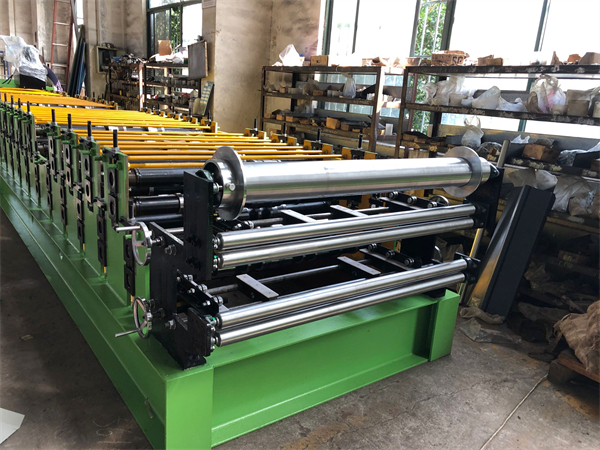
Cost Analysis
Equipment Cost Range – $100,000 to $500,000
- Entry models with basic features : $100k – $250k
- Advanced automated lines with cutters, punches: $250k – $500k
- Medium range around $300,000 suitable for most needs
Operating Cost Drivers
- Manual vs automated material handling
- Skilled vs semi-skilled labor
- Preventive maintenance expenses
- Energy consumption patterns
Payback Period
- 2 – 3 years typically by replacing manual processes
- Accounting for direct labor savings
- Improved quality and reliability
Cost Comparison – Inhouse Fabrication
- Lower volumes – Manual fabrication competitively priced
- Higher volumes – Inhouse machine offers significant savings
- Breakeven volumes around 1000 tons per year
The fast payback ensures manufacturers benefit from investing in stud and track making equipment versus outsourced supply or manual production.
पूछे जाने वाले प्रश्न
Q: What materials can be formed into studs and tracks?
A: Most commonly G90 galvanized steel coils are used. Other materials like stainless steel, aluminum, mild steel is also possible through roller die changes.
Q: Can these make custom profiles and holes?
A: Yes, advanced programmable machines allow forming special profiles. Punching units can provide custom hole patterns.
Q: How to increase production speed?
A: Using high grade steel materials with good surface finish quality allows increasing line speeds above 50 m/min. Automated lubrication, and radio frequency/induction heating systems also help reach higher metal forming rates.
Q: What precautions are required during installation?
A: Careful handling and positioning, checking alignments, trial runs without load, testing emergency stops thoroughly.
Q: How much area is needed for a stud and track roll forming line?
A: Around 25ft x 65ft including the machine (16ft x 55ft) and input/output zones. Heights up to 16ft clearance.
निष्कर्ष
Stud and track roll forming lines are a vital equipment for construction industry players to make light gauge steel wall framing products inhouse. Companies venturing into manufacturing these components can benefit from the high productivity, consistency, and cost-effectiveness offered by the latest metal stud and track making machines compared to outsourcing or manual methods. With capabilities to form standard as well as customized profiles, integrate punching and cutting functions, these represent a strategic investment for bulk suppliers of drywall framing materials and related products. By selecting a machine variant equipped with the right automation features corresponding to their production volumes and ensuring proper installation and maintenance, manufacturers can maximize their return on investment in this equipment.
